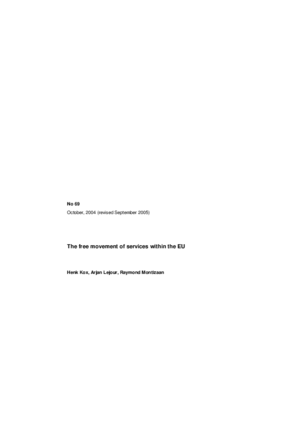The free movement of services within the EU
Regulation hampers trade in services
Since this subject is of topical interest, CPB has revised its previous reports CPB Document 69 and the CPB Communication of 23-9-2004.
Researchers Henk Kox and Arjan Lejour of CPB Netherlands Bureau of Economic Policy Analysis (CPB) draw these conclusions in CPB Discussion Paper 49, 'Regulatory heterogeneity as obstacle for international services trade' which is published today. This report is a scientific deepening of previous research on the Services Directive which has been published in CPB Document 69, 'The free movement of services within the EU'.
Within international trade, services trade is often considered as the poor cousin. Services contribute only 20 per cent to total exports, while the share of services in GDP is about 70 per cent. Services are often thought to be non-tradable. The degree of regulation contributes to the limited tradability. Services markets are more regulated than goods markets. The difficulties in assessing the quality of services before the purchase constitute an important reason for this difference. Governments have implemented regulations to guarantee the quality of the provision of services, for example by requiring minimal professional qualifications.
Differences in regulation between the exporting and importing country hamper trade. The service exporter has to fulfil the regulation requirements of both countries. Every time the service exporter wants to enter a new foreign market, he has to fulfil the requirements of that country. The smaller the differences in regulation, the larger trade in services will be. The country-specific regulations increase fixed costs, often independent of the size of the providers. Therefore, small and medium-sized enterprises are most hampered in their export activities. The researchers explain the volume of trade in commercial services between EU Member States by differences in regulation, the intensity of regulation, and other characteristics, such as the in-between distance, and the economic size of the countries. The authors conclude that trade could triple if the differences in regulation were to disappear completely (resulting in identical regulation in the EU). The implementation of the Services Directive will diminish the differences in regulation so much that trade could increase by 30 per cent to 60 per cent. A previous study by CPB provided a lower estimate of 15 to 35 per cent.
The researchers conclude now that the implementation of the directive implies larger trade effects than presented in previous reports. The method to handle the trade and regulations data, which has been used in the earlier analyses, proved to be not entirely correct. These shortcomings have been repaired in the new analysis. As a result, the trade effects are larger. The corrections have no consequences for the estimated effect on foreign direct investment in services, as presented in the previous studies.
Read also the accompanying press release.
We have developed an index for bilateral heterogeneity in product-market regulation, and apply it to the OECD Regulation Database. We show that the heterogeneity in regulation hampers bilateral service trade in the EU, and also bilateral direct investment.
We investigate how the proposed EU directive could lower the intra-EU heterogeneity in product market regulation for services, and what effect this would have on bilateral trade and investment in the Internal Market for services. We find that commercial services trade in the EU might increase by 15-30%, while the foreign direct investment stock in services might rise by 20-35%.

